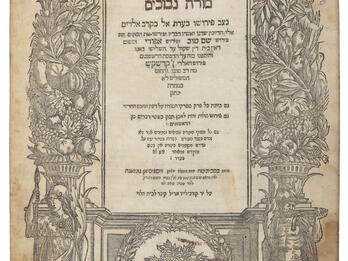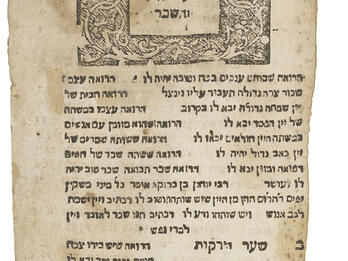Dedication (to Gracia Nasi): Consolações às Tribulações de Israel
Samuel Usque
1553
Dedication to the Very Illustrious Lady Doña Gracia Nasi
The heart is prized as the human body’s noblest and most important organ, for it is the first to feel the pain which any other part of the body suffers. Indeed, it must be kept content for all the others to be at ease.
Since my prime purpose is to serve our Portuguese nation with this small…
Creator Bio
Samuel Usque
Not much is known of Samuel Usque beyond a passage in his Consolação às tribulações de Israel (Consolation for the Tribulations of Israel) in which he describes himself as coming from a family of Portuguese New Christians of Spanish descent. He is thought to have been born in the early sixteenth century in Lisbon to a family originally from Huesca, Spain, and to have visited Salonika and Safed before settling in Ferrara, Italy, in the middle of the century. Usque was fluent in various languages and well-versed in classical, biblical, Jewish, and Christian literature. His sole work, written in the form of a Renaissance pastoral dialogue, appeals to New Christians to return to Judaism. It is cast in the form of a dialogue among three shepherds, one of whom, Ycabo (the Jewish people), recounts the history and tribulations of the Jewish people. The other two represent memory and consolation, respectively. The text, which he dedicated to Doña Gracia Nasi, provides insight into the contemporary reality as well as Usque’s personal experiences. Scholars consider Consolation for the Tribulations of Israel to be a significant work of both Jewish historiography and Portuguese literature. Most copies of the first edition (Ferrara, 1553) were destroyed by the Inquisition.
Related Guide
Jewish Printing and Book Culture
Jewish printing unified far-flung communities by standardizing religious texts, created textual uniformity, and enabled vernacular translations, and facilitated the spread of Jewish texts and knowledge.
Related Guide
Early Modern Italy: Where East and West Meet
Ashkenazim, Sephardim, and Marranos encountered each other in Italian cities, developing community structures that later influenced Jewish communal organization throughout the western world.
Related Guide
Early Modern Jewish Languages
As Ashkenazi and Sephardi Jews migrated eastward, Yiddish and Ladino emerged as distinct languages. Both languages developed literary traditions, as print became more widespread.
You may also like
Dedication (to Gracia Nasi): Ferrara Bible
Leḥem Yehudah (The Bread of Judah): On the Fate of the First Edition

Moses Maimonides’ Guide of the Perplexed



